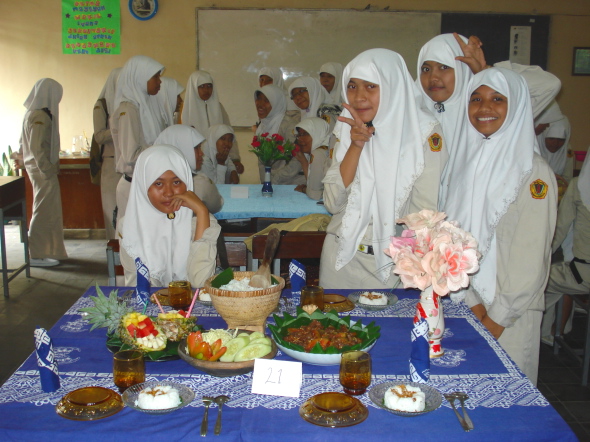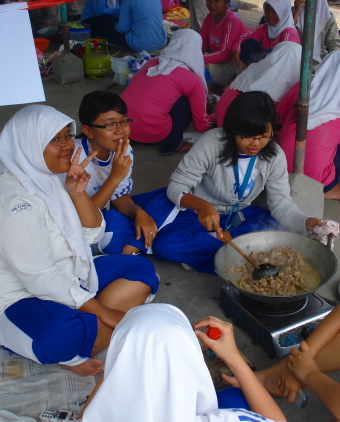Najib Kailani
Muslims and non-Muslims working together to win the annualcooking competitionNajib Kailan |
The Indonesian government is keen to increase the number of vocational schools in the country, seeing them both as a way to enhance the job prospects of school-leavers and as a way to build the human resource base of the country. Vocational schools aim to produce job-ready workers in automotive mechanics. computer software or hardware, accountancy, tourism, office administration and marketing. As elsewhere, in Indonesia they usually specialise - a practice that leads to particular schools being dominated by students of a particular sex. Predictably, schools teaching 'masculine' skills like automotive mechanics mainly cater to boys while schools teaching office skills or preparing students for other 'feminine' occupations like catering are dominated by girls.
Because vocational schools cater to lower socio-economic groups, one might expect them to be inclusive and egalitarian in their school culture. However, the specialisation of vocational schools and their narrow perspectives on religious expression sometimes result in gender favouritism and religious discrimination. In one vocational high school where this was the case, acts of resistance from students and teachers succeeded in partly reversing the trend - in the process, making their school culture more accepting of difference.
Gender favouritism
Ridha had planned to study at an academic high school and continue to university, but his family's economic circumstances ruled this out. He finally applied to enrol at a vocational high school specialising in office administration. When he first arrived, he was the only boy in the school. Because of this, he felt uncomfortable at school and often isolated himself from the other students. A teacher described how Ridha seemed to find it difficult to mix: 'In the break time, Ridha usually went to the back of the school to talk with some male construction workers who were building a new school building.' A year later, he was joined by nine other boys, but girls still made up 99 per cent of the student body.
Ridha had enrolled in the school when it was attempting to balance the gender composition by recruiting male students. The school principal explained that this program was designed in order to counter-balance the image of the school as a girls' school because of its specialisation. But boys are still in the minority and are recognised as 'special'. For instance, the school tempts prospective male students by allowing them to pay the tuition fees in three instalments if their families can't afford to pay them all at once. There is no such concession for female students.
Some teachers even treat boys differently in class. Deny and Sam, two male students, say that their teachers generally turn a blind if they don't bring their text books to class or don't get their homework done. But female students are punished if they break the same rules. This 'gender favouritism' stimulates jealousy among the female students. Novi and Noni, for example, see it as a form of discrimination. Although their school needs a gender balance and is recruiting male students to erase the image of female specialisation, they argue that there is no reason for special treatment.
Religious discrimination
Non-Muslims form another minority. Rita and the 24 other non-Muslim students at the school are referred to by their Muslim classmates as 'nonis' meaning 'non-Islam'. Female non-Muslim students are immediately identifiable because the school has an unwritten regulation requiring female Muslim students to wear headscarves. The fact that Rita didn't wear a headscarf meant that her classmates knew immediately that she was not Muslim. Some students distanced her because of this, prompting her to mix mainly with non-Muslim students. Luckily, not all Muslim students reacted this way and Rita now has many Muslim friends at school.
According to the school principal, the headscarf regulation was based on an agreement between the school and the students. He explained that the headscarf was made mandatory for Muslim students because the majority of students in his school are Muslim. The principal argues that the regulation is intended to encourage good behaviour among female students not only on school days but also in their everyday life. In other words, wearing the headscarf will remind female students not to engage in religiously unacceptable practices like having premarital sex or using drugs. However, most students say that they are uncomfortable with the headscarf regulation because their school is not an Islamic school. They think that their public school should accommodate diverse student backgrounds.
Officially, the headscarf required by the school should cover the hair and look neat. But some female students who do not agree with the headscarf regulation resist by wearing fashionable headscarves that show their pony-tails at school, which they remove after school hours. This decision brings consequences. One Islamic Studies teacher immediately reprimands female students whose headscarves fail to completely hide their pony-tails.
Another policy that triggered resistance was the introduction of special classes in Qur'anic recitation. Muslim students were offered these special classes every morning before class. This discriminatory practice triggered protests from non-Muslim teachers, who gathered all the non-Muslim students together - among them Catholics, Protestants and Hindus - to hold a morning prayer in the school corridors. This protest stimulated discussion about a morning prayer program for non-Muslims. In response, the school provided a prayer room for use by all non-Muslim students.
Cultivating a sense of togetherness
There is one popular program at the school that bridges the diverse background of students - a cooking competition held for Idul Adha, the Muslim festival that celebrates Abraham's willingness to sacrifice his son to God. Even though the event celebrates an Islamic holy day, the competition involves all students. It was initiated and is coordinated by students in 'Kerohanian Islam' or 'Rohis' (the Islamic studies group), a part of the school's student association, who invite all class representatives to meet and discuss the rules of the competition.
The event starts in the morning with the sacrifice and killing of cows or goats in the school, led by an Islamic religious teacher. The meat is distributed to poor students, who are identified by the core committee. During the process of cutting up and distributing the meat, the Muslim students gather in the school hall to listen to a sermon by a preacher. Meanwhile, 24 groups of five students each prepare cooking utensils in a special area of the school yard. After the distribution of meat, they start to cook. When choosing the cooking teams the committee gives priority to the non-Muslim students, who are exempted from attending the sermon, so that they can participate alongside their Muslim student partners.
 |
Students prepare a table of food and decorate it with flowersNajib Kailan |
When the food is ready, another group of students prepares a table of food, decorated with flowers to be judged by the teachers. After the judging, all the students eat together in their respective classrooms. Most teachers and students in the school - Muslims and non-Muslims - feel that the cooking competition and communal meal fosters a sense of togetherness amongst the students of the school.
Through the tradition of the cooking competition and shared meal to celebrate Idul Adha, the school deliberately cultivates a sense of togetherness. At the same time, it reinforces difference through its policies of gender favouritism and religious discrimination. The tension between these different policies illustrates the complexities associated with attempts to be inclusive. But in this school, at least, actions such as wearing a shorter headscarf or demanding religious facilities for non-Muslim students help push the balance in the direction of inclusiveness, showing that teachers and students have the power to help promote a more multicultural culture.
Najib Kailani (najib_kailani@yahoo.com) is a researcher at the Centre for Southeast Asian Social Studies (CESASS) Gadjah Mada University of Yogyakarta.
This article is part of the Learning to Belong feature edition.
